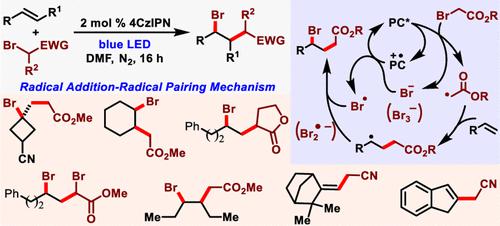当前位置:
X-MOL 学术
›
ACS Catal.
›
论文详情
Our official English website, www.x-mol.net, welcomes your
feedback! (Note: you will need to create a separate account there.)
Catalytic Photoredox Carbobromination of Unactivated Alkenes with α-Bromocarbonyls via the Mechanistically Distinct Radical-Addition Radical-Pairing Pathway
ACS Catalysis ( IF 11.3 ) Pub Date : 2024-04-05 , DOI: 10.1021/acscatal.4c00955
Harshvardhan Singh 1 , Raj K. Tak 1 , Dhruba P. Poudel 1 , Ramesh Giri 1
ACS Catalysis ( IF 11.3 ) Pub Date : 2024-04-05 , DOI: 10.1021/acscatal.4c00955
Harshvardhan Singh 1 , Raj K. Tak 1 , Dhruba P. Poudel 1 , Ramesh Giri 1
Affiliation

|
We disclose a catalytic photoredox carbobromination of unactivated alkenes with α-bromocarbonyl compounds under blue-light-emitting diode (LED) light. The reaction proceeds with α-bromoesters, α-bromonitriles, and α-bromo-γ-lactones along with terminal and 1,2-disubstituted internal alkenes. Reactions with indenes and 1,1-disubstituted alkenes generate alkylated alkenes. Mechanistic studies by product selectivity and three-way competitive crossover experiments suggest that the reaction operates by a radical-addition radical-pairing (RARP) mechanism. The catalytic turnover is achieved by a single electron reduction of PC•+ by Br– (or Br3–), rather than by the alkyl radical (R•), and the product is generated by the pairing of Br• (or Br2•–) and R•, instead of the combination of Br– and a carbocation (R+).
中文翻译:

未活化烯烃与α-溴羰基的催化光氧化还原碳溴化,通过机制上不同的自由基-加成自由基配对途径
我们公开了在蓝光发光二极管 (LED) 光下未活化烯烃与 α-溴羰基化合物的催化光氧化还原碳溴化反应。反应进行α-溴酯、α-溴腈和 α-溴-γ-内酯以及末端和 1,2-二取代的内部烯烃。与茚烃和 1,1-二取代烯烃反应生成烷基化烯烃。通过产物选择性和三方竞争叉实验进行的机理研究表明,该反应通过自由基-加成自由基配对 (RARP) 机制进行。催化转换是通过 Br–(或 Br3–)而不是烷基自由基 (R•) 对 PC•+ 进行单电子还原来实现的,产物是由 Br•(或 Br2•–)和 R•配对产生的,而不是由 Br– 和碳阳离子 (R+) 的组合产生的。
更新日期:2024-04-05
中文翻译:

未活化烯烃与α-溴羰基的催化光氧化还原碳溴化,通过机制上不同的自由基-加成自由基配对途径
我们公开了在蓝光发光二极管 (LED) 光下未活化烯烃与 α-溴羰基化合物的催化光氧化还原碳溴化反应。反应进行α-溴酯、α-溴腈和 α-溴-γ-内酯以及末端和 1,2-二取代的内部烯烃。与茚烃和 1,1-二取代烯烃反应生成烷基化烯烃。通过产物选择性和三方竞争叉实验进行的机理研究表明,该反应通过自由基-加成自由基配对 (RARP) 机制进行。催化转换是通过 Br–(或 Br3–)而不是烷基自由基 (R•) 对 PC•+ 进行单电子还原来实现的,产物是由 Br•(或 Br2•–)和 R•配对产生的,而不是由 Br– 和碳阳离子 (R+) 的组合产生的。































 京公网安备 11010802027423号
京公网安备 11010802027423号